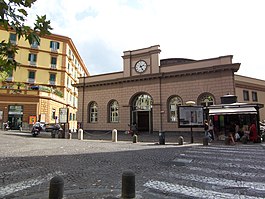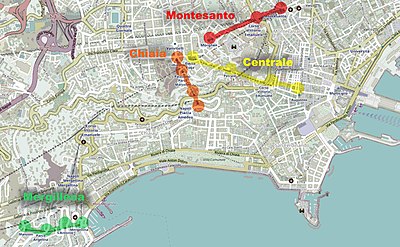This article needs additional citations for verification. (April 2017) |
| Chiaia funicular | |||||||||||||||||||||||||||||||||||||||||||||||||||||||||||||
|---|---|---|---|---|---|---|---|---|---|---|---|---|---|---|---|---|---|---|---|---|---|---|---|---|---|---|---|---|---|---|---|---|---|---|---|---|---|---|---|---|---|---|---|---|---|---|---|---|---|---|---|---|---|---|---|---|---|---|---|---|---|
 Via Cimarosa station | |||||||||||||||||||||||||||||||||||||||||||||||||||||||||||||
| Overview | |||||||||||||||||||||||||||||||||||||||||||||||||||||||||||||
| Native name | Funicolare di Chiaia | ||||||||||||||||||||||||||||||||||||||||||||||||||||||||||||
| Status | in use[citation needed] | ||||||||||||||||||||||||||||||||||||||||||||||||||||||||||||
| Locale | Naples, Italy | ||||||||||||||||||||||||||||||||||||||||||||||||||||||||||||
| Stations | 4 | ||||||||||||||||||||||||||||||||||||||||||||||||||||||||||||
| Service | |||||||||||||||||||||||||||||||||||||||||||||||||||||||||||||
| Type | Funicular | ||||||||||||||||||||||||||||||||||||||||||||||||||||||||||||
| Operator(s) |
| ||||||||||||||||||||||||||||||||||||||||||||||||||||||||||||
| History | |||||||||||||||||||||||||||||||||||||||||||||||||||||||||||||
| Opened | 1889 | ||||||||||||||||||||||||||||||||||||||||||||||||||||||||||||
| Technical | |||||||||||||||||||||||||||||||||||||||||||||||||||||||||||||
| Line length | 0.5 km (0.31 mi) | ||||||||||||||||||||||||||||||||||||||||||||||||||||||||||||
| Track gauge | 1,435 mm (4 ft 8+1⁄2 in) | ||||||||||||||||||||||||||||||||||||||||||||||||||||||||||||
| |||||||||||||||||||||||||||||||||||||||||||||||||||||||||||||
The Chiaia funicular (Italian: Funicolare di Chiaia) is one of four funiculars in the public transportion system of Naples, Italy. Each system is a true funicular: an inclined railway with two passenger cars connected via cables, operating in concert.
Opened in 1889, the Chiaia Funicular is one of the oldest funicular railways in the world, and carries over half a million passengers per year.[1]
The line connects its upper terminus in Vomero to its lower terminus in Chiaia via four stations: Cimarosa Station, Palazzolo Station, Corso Vittorio Emanuele Station, and Regina Magherita Station. It primarily connects Piazza Vanvitelli, at the top of Vomero Hill, to Rione Amadeo.
The line connects with Line 1 of the Naples Metro and the central funicular at Via Cimarosa, and with Line 2 at Via Regina Margherita.
At Cimarosa the Chiaia is connected by an underground tunnel to both Vanvitelli station, on Line 1 of the Naples Metro, and to the Central Funicular.
The Montesanto Funicular is a short walk to the northeast. A fourth funicular, the Mergellina funicular, connects Posillipo Alto with the city's Mergellina area. A now defunct system, the Sorrento Funicular, operated nearby from 1883 to 1886.

At the Chiaia funicular the exterior of the upper station features a latin quote (in two parts, on either side of the building, in gold lettering on a maroon band, in the upper frieze): "Time by itself does not exist; but from things themselves there results a sense of what has already taken place, what is now taking place and what will take place. It must not be claimed that anyone can sense time by itself, apart from the movement of things." (IL TEMPO, Roman poet, Lucretius, De rerum natura (On the Nature of Things), Book I, 459).
- ^ "Funicolare Chiaia". Metro Napoli (in Italian). Archived from the original on 22 July 2011.